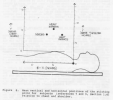Kenny Croxdale
Level 7 Valued Member
Bench Press Technique Bar Path
One of the keys to moving more weight in movement is finding the least path of resistance.
With that said, let's look at how to increase your Bench Press based on research by...
Dr Tom McLaughlin (PhD Exercise Bio-Mechanics/Former Powerlifter)
In 1984, McLaughlin's research examine some of the differences between Elite World Record Holders in the Bench Press did and Novice Bench Pressers.
In other words, what were the Elite Bencher doing right and what were the Novice Benchers doing wrong.
McLaughlin went into greater depth about this is his book, "Bench Press More Now"; now out of print.
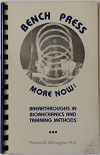
I have McLaughlin's book. It is one of the best on Bench Pressing.
Pre-Bench Press Shirt Research
McLaughlin's research is based on Bench Pressing in a T-Shirt. The Bench Press Shirts had not been introduced to the sport.
With that in mind, a Bench Press Shirt changes the dynamics of the lift; meaning that the Bar Path will be different.
There's no data on the what Bar Path occurs in the Bench Press, when a Bench Press Shirt is worn.
Two Groups To Learn From
As with everything in life, there are two group that you can learn from...
1) Successful Individuals: Find out what they are doing right and emulate them.
2) Unsuccessful Individuals: Find out what they are doing wrong and avoid it.
Dr Greg Nuckols does a nice job of examining McLaughlin's research data in his article...
Bench Press Bar Path: How to Fix Your Bar Path for a Bigger Bench
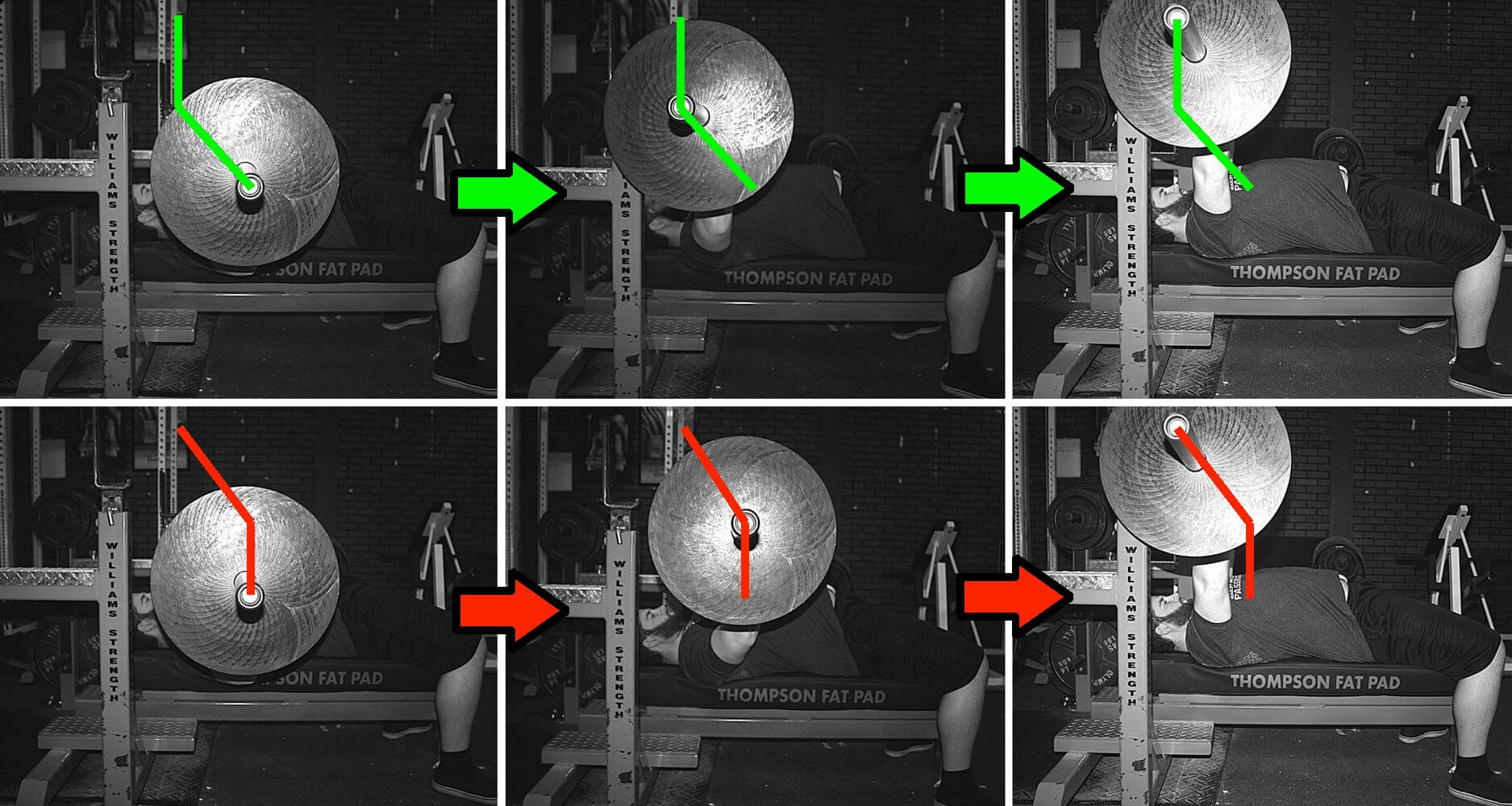
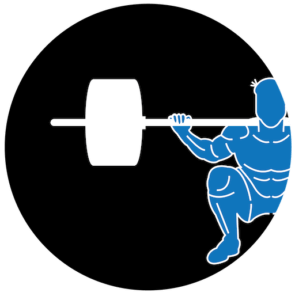 www.strongerbyscience.com
www.strongerbyscience.com
As demonstrated below, the Bar Path examined three Bench Pressers...
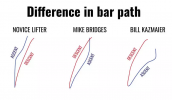
1) Novice Lifter Bar Path was less effective than the Elite Bench Pressers.
2) Elite Lifters Bar Paths were somewhat similar; Smaller vs Larger Elite Bench Pressers.
What McLaughlin determined was that the Bar Path varied due to the size difference in the Lighter Weight Lifter (Mike Bridges, 181 lbs, about 5'3") and the Heavier Weight Lifter (Bill Kazmaier, 320 lbs, 6'2").
Both Bridges and Kazmaier's hand grip was at the rule limit of 81 cm (about 32")
Due the difference in their arm length, the Bar Path was slightly different for Lighter vs Heavier Lifters.
" This is where McLaughlin’s research comes into play.:
"The novice lifters initiated the press by shoving the bar essentially straight up off their chest, with the bar path angled back only slightly. Since the bar didn’t move back toward their shoulders very much, total flexion demands at the shoulders were still very high (relative to the load they were lifting) when the bar reached the sticking point of the lift a few inches off the chest."
"The elite lifters, on the other hand, initiated the press by shoving the bar up off their chests and back toward their shoulders. Since the bar did move back toward their shoulders, total flexion demands at the shoulders decreased as the bar approached the sticking point."
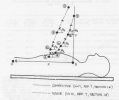 ''
''
Average bench press bar paths for novice lifters (dashed line) vs. elite lifters (solid line). Especially pay attention to the short segment between points 4 and 6 on each line."
"...Both groups of experts had much less horizontal distance between the bar and their shoulders than did the novice group. This helps minimize the total shoulder flexion demands, increasing how much force they could apply to the bar."
Bridge Increased His Bench Without Getting Stronger
One of the most interesting pieces of reach from McLaughlin was on how Bridges increased his Bench Press World Record without getting stronger...
"Mike Bridges added 60lbs to his bench in a year (386 to 446) by altering his bar path to dramatically increase the minimum force he could exert on the bar. Force = mass x acceleration, and the minimum acceleration (labeled “7” on both graphs, coinciding with minimum force) increased dramatically between 1978 and 1979, allowing him to bench more even as maximum acceleration decreased (maximum force still increased a bit though, because there was more weight on the bar). This is the hallmark of more efficient technique: minimum force during the movement approaching maximum force.{Mike Bridges added 60lbs to his bench in a year (386 to 446) by altering his bar path to dramatically increase the minimum force he could exert on the bar. Force = mass x acceleration, and the minimum acceleration (labeled “7” on both graphs, coinciding with minimum force) increased dramatically between 1978 and 1979, allowing him to bench more even as maximum acceleration decreased (maximum force still increased a bit though, because there was more weight on the bar). This is the hallmark of more efficient technique: minimum force during the movement approaching maximum force."
Summary
1) Bench Press Path Trajectory
Research demonstrates the most effective method of driving more weight up in your Bench Press is to essentially push the weight back toward your head, in an arc.
2) Trying to push the weight straight up in a Bench Press is counter productive; it ensures you are going to encounter more force, the weight of the bar is magnified beyond its true weight.
3) McLaughlin's research also examines how the Eccentric Speed in lowering the bar plays vital role in your Bench Press Max.
4) The key to developing Bench Press Technique (which is the same with all movements) involves the use of heavy loads performed for one repetition.
5) There is a needs for training the Competition Bench Press with a "Touch and Go" (developing the Stretch Reflex) as well as training the Bench with a Competition Pause.
6) Increasing your Bench Press is accomplished with Auxiliary Exercises that are similar in nature to the Bench Press. Developing strength in the Competition Bench Press with multiple repetition in a set leads to muscle fatigue; meaning your technique and the muscle firing sequence of the muscle in the Bench Press change.
One of the keys to moving more weight in movement is finding the least path of resistance.
With that said, let's look at how to increase your Bench Press based on research by...
Dr Tom McLaughlin (PhD Exercise Bio-Mechanics/Former Powerlifter)
In 1984, McLaughlin's research examine some of the differences between Elite World Record Holders in the Bench Press did and Novice Bench Pressers.
In other words, what were the Elite Bencher doing right and what were the Novice Benchers doing wrong.
McLaughlin went into greater depth about this is his book, "Bench Press More Now"; now out of print.

I have McLaughlin's book. It is one of the best on Bench Pressing.
Pre-Bench Press Shirt Research
McLaughlin's research is based on Bench Pressing in a T-Shirt. The Bench Press Shirts had not been introduced to the sport.
With that in mind, a Bench Press Shirt changes the dynamics of the lift; meaning that the Bar Path will be different.
There's no data on the what Bar Path occurs in the Bench Press, when a Bench Press Shirt is worn.
Two Groups To Learn From
As with everything in life, there are two group that you can learn from...
1) Successful Individuals: Find out what they are doing right and emulate them.
2) Unsuccessful Individuals: Find out what they are doing wrong and avoid it.
Dr Greg Nuckols does a nice job of examining McLaughlin's research data in his article...
Bench Press Bar Path: How to Fix Your Bar Path for a Bigger Bench

Bench Press Bar Path: How to Fix Your Bar Path for a Bigger Bench
There is a simple bench press bar path tweak that can make a big difference. Learn how to optimize your bar path for a bigger bench.
As demonstrated below, the Bar Path examined three Bench Pressers...

1) Novice Lifter Bar Path was less effective than the Elite Bench Pressers.
2) Elite Lifters Bar Paths were somewhat similar; Smaller vs Larger Elite Bench Pressers.
What McLaughlin determined was that the Bar Path varied due to the size difference in the Lighter Weight Lifter (Mike Bridges, 181 lbs, about 5'3") and the Heavier Weight Lifter (Bill Kazmaier, 320 lbs, 6'2").
Both Bridges and Kazmaier's hand grip was at the rule limit of 81 cm (about 32")
Due the difference in their arm length, the Bar Path was slightly different for Lighter vs Heavier Lifters.
" This is where McLaughlin’s research comes into play.:
"The novice lifters initiated the press by shoving the bar essentially straight up off their chest, with the bar path angled back only slightly. Since the bar didn’t move back toward their shoulders very much, total flexion demands at the shoulders were still very high (relative to the load they were lifting) when the bar reached the sticking point of the lift a few inches off the chest."
"The elite lifters, on the other hand, initiated the press by shoving the bar up off their chests and back toward their shoulders. Since the bar did move back toward their shoulders, total flexion demands at the shoulders decreased as the bar approached the sticking point."
 ''
''Average bench press bar paths for novice lifters (dashed line) vs. elite lifters (solid line). Especially pay attention to the short segment between points 4 and 6 on each line."
"...Both groups of experts had much less horizontal distance between the bar and their shoulders than did the novice group. This helps minimize the total shoulder flexion demands, increasing how much force they could apply to the bar."
Bridge Increased His Bench Without Getting Stronger
One of the most interesting pieces of reach from McLaughlin was on how Bridges increased his Bench Press World Record without getting stronger...
"Mike Bridges added 60lbs to his bench in a year (386 to 446) by altering his bar path to dramatically increase the minimum force he could exert on the bar. Force = mass x acceleration, and the minimum acceleration (labeled “7” on both graphs, coinciding with minimum force) increased dramatically between 1978 and 1979, allowing him to bench more even as maximum acceleration decreased (maximum force still increased a bit though, because there was more weight on the bar). This is the hallmark of more efficient technique: minimum force during the movement approaching maximum force.{Mike Bridges added 60lbs to his bench in a year (386 to 446) by altering his bar path to dramatically increase the minimum force he could exert on the bar. Force = mass x acceleration, and the minimum acceleration (labeled “7” on both graphs, coinciding with minimum force) increased dramatically between 1978 and 1979, allowing him to bench more even as maximum acceleration decreased (maximum force still increased a bit though, because there was more weight on the bar). This is the hallmark of more efficient technique: minimum force during the movement approaching maximum force."
Summary
1) Bench Press Path Trajectory
Research demonstrates the most effective method of driving more weight up in your Bench Press is to essentially push the weight back toward your head, in an arc.
2) Trying to push the weight straight up in a Bench Press is counter productive; it ensures you are going to encounter more force, the weight of the bar is magnified beyond its true weight.
3) McLaughlin's research also examines how the Eccentric Speed in lowering the bar plays vital role in your Bench Press Max.
4) The key to developing Bench Press Technique (which is the same with all movements) involves the use of heavy loads performed for one repetition.
5) There is a needs for training the Competition Bench Press with a "Touch and Go" (developing the Stretch Reflex) as well as training the Bench with a Competition Pause.
6) Increasing your Bench Press is accomplished with Auxiliary Exercises that are similar in nature to the Bench Press. Developing strength in the Competition Bench Press with multiple repetition in a set leads to muscle fatigue; meaning your technique and the muscle firing sequence of the muscle in the Bench Press change.
Last edited:

